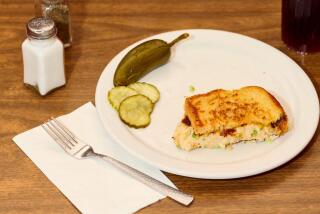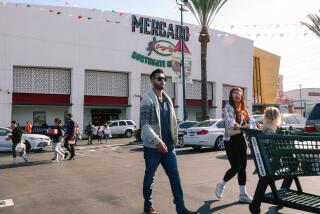Southern California’s great citrus had its crate advertising
They’re bright. They’re bold. They’re eye-catching.
California orange crate labels are viewed as quaint kitchen decor today, but there was a time when the colorful logos were cutting-edge innovations in national marketing.
It wasn’t long after the completion of the first transcontinental railroad in 1869 that California’s citrus economy exploded, thanks to a mild climate and easy access to water. From 1880 to 1893, California citrus acreage grew from a few thousand acres to more than 40,000 — with 90% of it in Southern California, according to Tom Spellman, president of the Citrus Label Society.
From San Diego to Santa Barbara, thousands of growers were eager to sell their goods to a hungry nation and looking for a competitive edge. “Everyone knew the product was basically the same; an orange is an orange, a lemon a lemon, a grapefruit a grapefruit,” Spellman said. Growers responded by choosing catchy brand names and images to identify their product, then putting them on labels and pasting them onto wooden crates.
From the 1880s until the late 1950s, when preprinted cardboard boxes replaced the crates, some 8,000 designs were created, according to Spellman.
Packinghouses often created three different labels: one for high-grade fruit, one for mid-grade and one for the bottom of the barrel — citrus that was small, poorly textured or off-color. The fruit in this last category didn’t necessarily taste bad, but it looked bad. Growers sometimes chose scruffy dogs or ugly old ladies to represent these grades. One Villa Park brand, “Camouflage,” carried the slogan: “The Quality is Inside.” Another brand, “Mutt,” proclaimed: “Not much for looks, but ripe, sweet & juicy.”
Label art generally falls into three basic design eras, according to Gordon McClelland, author of “California Orange Box Labels.” Those are “Naturalistic,” from about 1885 to 1915; “Advertising,” from 1915 to 1935; and “Commercial Art,” from 1935 to 1955. The early style often depicted awe-inspiring Southern California scenes such as snow-capped mountains, pristine citrus groves and broad beaches dotted with sun umbrellas. Others reflected the area’s Mexican and Spanish heritage, depicting cowboys, Indians and California missions.
These idyllic scenes were selling more than just oranges and lemons; they were selling California. “I’m sure that many people made their decision to move west as they were eating their navel oranges and saw the beautiful scenery on the box,” Spellman said.
Even back then, advertisers knew that sex sells.
“Some labels showed pictures of women that bordered on being racy,” Spellman said. The Siren brand from Borden Fruit Co. in Anaheim showed a sultry blond with a low-cut neckline and gaudy gold necklace. The Tesoro label from Bradford Bros Inc. in Placentia depicted a skimpily clad pirate babe.
Around 1922, the California Fruit Growers Exchange (later Sunkist) realized a flaw in its marketing strategy, McClelland said. Here they were selling oranges, but many of the growers’ labels didn’t show the product. They redesigned them with the fruit as the main image, ushering in the “advertising” phase of label art. The final phase of label design emerged in 1935, when the brand name became the star of the label, often spelled out in bold three-dimensional-looking block letters in a style that presaged Pop Art, McClelland said.
Commonly, one artist would sketch the label, often in watercolor, while another would painstakingly translate the image into six- to 12-color stone lithographs. Another artist would hand-letter the brand name and any other writing. An art director would oversee the production.
Though a few famous painters dabbled in citrus label design, the majority of sketch artists were unknowns who worked for low wages at lithograph houses in San Francisco and Los Angeles. They didn’t even get the satisfaction of signing their work. “The lithograph companies didn’t want one artist to become better-known than another one, because if one became famous, they’d have to pay him more,” McClelland said.
The lettering specialists were pros in their own right. Many were aging bank-note engravers from the East or Midwest whose eyesight was fading, according to McClelland. “They came out west to retire and ended up getting jobs doing label and poster lettering,” he said. “They were the best around at the time, which is why the lettering on the labels was so incredible.”
Yet when McClelland interviewed several former label artists in the 1970s, he found that “most of these guys were somewhat embarrassed of what they did. Being given a label design assignment was the low job on the totem pole in lithograph company art departments.”
If they were alive today, they might feel differently. Museums around the world have exhibited citrus labels, McClelland said. The labels are also a popular collector’s item; while most sell for under $100, a few have fetched as much as $6,000. Citrus label art also served as an inspiration for another budding art form of similar dimensions in the 1950s and ‘60s: album covers.
Above all, the labels will always have enduring value as a testament to a bygone era when the Southern California landscape was unspoiled and citrus was king.
More to Read
Start your day right
Sign up for Essential California for news, features and recommendations from the L.A. Times and beyond in your inbox six days a week.
You may occasionally receive promotional content from the Los Angeles Times.






